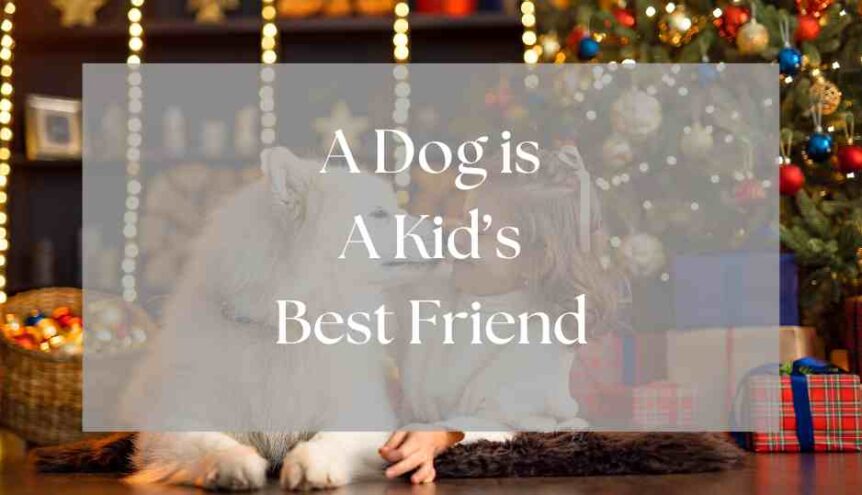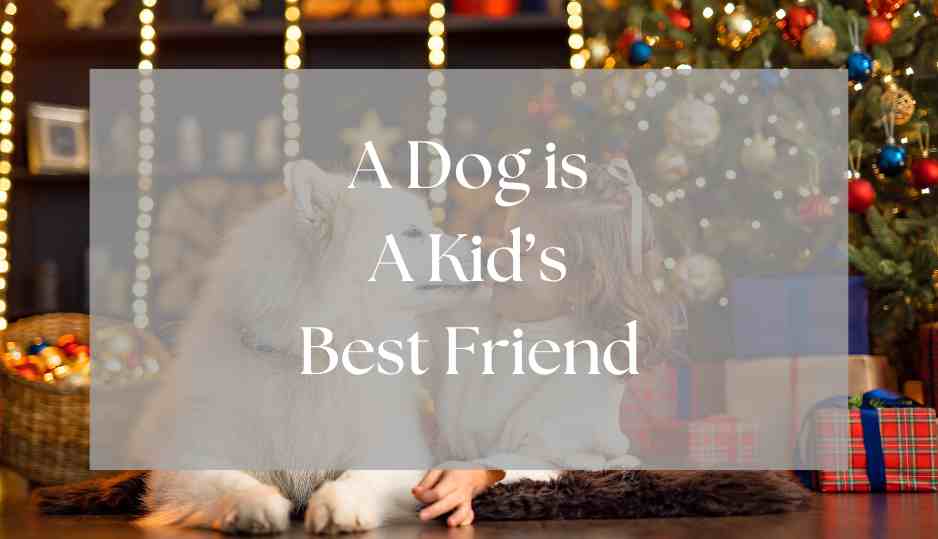A Dog is A Kid's Best Friend
When my son was little, my mom told me that every boy should have a dog. An unexpected statement from her since we didn’t have dogs growing up. With four sisters, my brother probably would have definitely benefitted from having a canine companion to call his own.
It wasn’t until I had kids of my own, and we moved out to the country, that I took dog ownership seriously. And yes, the kids definitely benefitted from it. It not only taught them responsibility, but they learned the value of training (in 4-H) and, my son especially, spent hours sharing his secrets with Buster.
In an earlier post, I listed a few brief positives dog ownership has on children. One of the reasons I’d like to expand on this is because it has a direct connection to A Canine Christmas. Amelia’s niece, Janie, is painfully shy. This was true of my own daughter Nikki. She was so quiet in kindergarten, teachers and other parents questioned her ability to connect with others. But interacting with her dogs and other pets changed that.
It wasn’t until I was actually writing this Christmas novella that Janie’s shyness, along with her love for dogs, appeared. I hadn’t planned it—one of those Holy Spirit moments that make writing an adventure for me. But when it happened in chapter two, much of the plot structure (and a reason for Amelia to pursue a relationship with Rayce) fell into place.
Dogs have an amazing ability to draw people from their shell. It’s partly due to a chemical reaction. Petting a dog increases the levels of oxytocin (the good feeling hormone) and decreases the levels of cortisol (the stress hormone). It’s that simple and that complicated all at the same time.
Yes, for most parents the first fear they have about getting a dog is the amount of work involved. When we got Casper (our 16-month-old Maltese) a little over a year ago, I was so enamored by his cuteness, I let it override common sense. And I’m glad I did. He brings so much enjoyment to not only me, but to my husband and granddaughters.
As I stated earlier, having a dog to care for helped teach my children responsibility. They learned valuable life skills such as feeding, grooming, exercising and training. Because we lived out in the country, they didn’t need to walk the dogs—they just needed to be outside playing with them, which was far better for them then sitting around inside.
Anything that will get kids moving is beneficial to their overall health. On average, children who have a dog in the home get eleven minutes more exercise a day than those who don’t—and this doesn’t include walking. This is just general playtime—wrestling, chasing, playing tug-of-war.
You’re probably thinking, Eleven minutes? Big deal. But those measly minutes add up to 5.5 hours a month and 66 hours a year. Get your kids out walking Fido, and there is a chance it can help combat childhood obesity—which is on the rise in the U.S.
Recent studies in pediatric health have shown that children who live with pets (and most especially dogs) have a better immune system than those who don’t. When it comes to exposure to allergens, the studies show the benefits to exposure to dogs in the first year of life is the most beneficial.
Even more impressive to me is how dogs can improve a child’s emotional intelligence.
When given the opportunity to practice caring for another living being, children learn to understand a dog’s needs, read its body language, and respond appropriately, thereby learning empathy.
And we’ve all heard how amazing therapy dogs can be.
Autism, ADD, and ADHD are on the rise in the U.S. Around 1 in 36 children have been identified with autism, and more than 11% of children between the ages of 3 and 17 have been diagnosed with ADHD. That’s an increase of 1 million children from 2016.
We can discuss the validity of ADHD and how other factors may be at play, but the symptoms are the symptoms regardless of the cause. Having a therapy dog creates consistency and routine, provides an outlet for all that excessive energy (thereby decreasing hyperactivity), and helps children cope with isolation and depression. Added to that, they take the stress out of new social situations.
For those kids with autism, a therapy dog provides a sense of security, decreases meltdowns, anxiety, and acts of aggression. At the same time, they increase the willingness of the child to try new things and face fearful situations.
Statistics also show that a therapy dog increases the child’s social interaction due to the dog being an ice breaker and taking the focus off the disability. They also increase verbal communication and vocabulary.
What’s not to love?
I could literally write a book about how beneficial dogs are to children (and adults, too). But due to limited time on my part and yours, I’ve touched on a few of the most important. I hope gives you an added appreciation for our furry friends.
Be sure to comment below for a chance to with the $25 Amazon Gift Card and the ebook version of A Canine Christmas. What in this post, if anything, surprised you about dog ownership? If you missed Monday’s, Tuesday’s, Wednesday’s, Thursday’s, Friday’s, or Saturday’s posts, be sure to visit and comment for more chances to win the giveaway.







